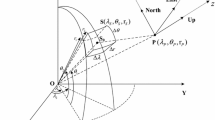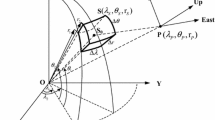Abstract
Various tasks in geodesy, geophysics, and related geosciences require precise information on the impact of mass distributions on gravity field-related quantities, such as the gravitational potential and its partial derivatives. Using forward modeling based on Newton’s integral, mass distributions are generally decomposed into regular elementary bodies. In classical approaches, prisms or point mass approximations are mostly utilized. Considering the effect of the sphericity of the Earth, alternative mass modeling methods based on tesseroid bodies (spherical prisms) should be taken into account, particularly in regional and global applications. Expressions for the gravitational field of a point mass are relatively simple when formulated in Cartesian coordinates. In the case of integrating over a tesseroid volume bounded by geocentric spherical coordinates, it will be shown that it is also beneficial to represent the integral kernel in terms of Cartesian coordinates. This considerably simplifies the determination of the tesseroid’s potential derivatives in comparison with previously published methodologies that make use of integral kernels expressed in spherical coordinates. Based on this idea, optimized formulas for the gravitational potential of a homogeneous tesseroid and its derivatives up to second-order are elaborated in this paper. These new formulas do not suffer from the polar singularity of the spherical coordinate system and can, therefore, be evaluated for any position on the globe. Since integrals over tesseroid volumes cannot be solved analytically, the numerical evaluation is achieved by means of expanding the integral kernel in a Taylor series with fourth-order error in the spatial coordinates of the integration point. As the structure of the Cartesian integral kernel is substantially simplified, Taylor coefficients can be represented in a compact and computationally attractive form. Thus, the use of the optimized tesseroid formulas particularly benefits from a significant decrease in computation time by about 45 % compared to previously used algorithms. In order to show the computational efficiency and to validate the mathematical derivations, the new tesseroid formulas are applied to two realistic numerical experiments and are compared to previously published tesseroid methods and the conventional prism approach.





Similar content being viewed by others
References
Álvarez O, Gimenez M, Braitenberg C, Folguera A (2012) GOCE satellite derived gravity and gravity gradient corrected for topographic effect in the South Central Andes region. Geophys J Int 190:941–959. doi:10.1111/j.1365-246X.2012.05556.x
Anderson EG (1976) The effect of topography on solutions of Stokes’ problem. Unisurv S-14, Rep, School of Surveying, University of New South Wales, Australia
Asgharzadeh MF, Von Frese RRB, Kim HR, Leftwich TE, Kim JW (2007) Spherical prism gravity effects by Gauss–Legendre quadrature integration. Geophys J Int 169(1):1–11. doi:10.1111/j.1365-246X.2007.03214.x
Baur O, Sneeuw N (2011) Assessing Greenland ice mass loss by means of point-mass modeling: a viable methodology. J Geod 85(9):607–615. doi:10.1007/s00190-011-0463-1
Braitenberg C, Ebbing J (2009) New insights into the basement structure of the West Siberian Basin from forward and inverse modeling of GRACE satellite gravity data. J Geophys Res 114:B06402. doi:10.1029/2008JB005799
Bronstein IN, Semendjajew KA, Musiol G, Mühlig H (2008) Taschenbuch der Mathematik. Verlag Harri Deutsch
D’Urso MG (2013) On the evaluation of the gravity effects of polyhedral bodies and a consistent treatment of related singularities. J Geod 87(3):239–252. doi:10.1007/s00190-012-0592-1
Farr TG, Rosen PA, Caro E, Crippen R, Duren R, Hensley S, Kobrick M, Paller M, Rodriguez E, Roth L, Seal D, Shaffer S, Shimada J, Umland J, Werner M, Oskin M, Burbank E, Alsdorf D (2007) The shuttle radar topography mission. Rev Geophys 45:RG2004. doi:10.1029/2005RG000183
Forsberg R (1984) A study of terrain reductions, density anomalies and geophysical inversion methods in gravity field modelling. Rep 355, Department of Geodetic Science and Surveying, The Ohio State University, Columbus, USA
Forsberg R (1985) Gravity field terrain effect computations by FFT. Bull Géod 59(4):342–360. doi:10.1007/BF02521068
Forsberg R, Tscherning C (1997) Topographic effects in gravity field modelling for BVP. In: Sansò F, Rummel R (eds) Geodetic boundary value problems in view of the one centimeter geoid. Lecture notes in earth sciences, vol 65. Springer, Berlin, pp 239– 272. doi:10.1007/BFb0011707
Grombein T, Seitz K, Awange JL, Heck B (2012) Detection of hydrological mass variations by means of an inverse tesseroid approach. In: General assembly of the European Geosciences Union 2012, Vienna, Austria, April 22–27, 2012. Geophysical research abstracts, vol 14, EGU2012-7548
Grombein T, Seitz K, Heck B (2010) Untersuchung zur effizienten Berechnung topographischer Effekte auf den Gradiententensor am Fallbeispiel der Satellitengradiometriemission GOCE. Rep 7547, KIT Scientific Reports, KIT Scientific Publishing, Karlsruhe, Germany. doi:10.5445/KSP/1000017531
Grombein T, Seitz K, Heck B (2013) Topographic–isostatic reduction of GOCE gravity gradients. In: Rizos C, Willis P (eds) Earth on the edge: science for a sustainable planet. Proceedings of the IAG general assembly, Melbourne, Australia, 2011. IAG Symposia, vol 139. Springer, Berlin (in print)
Grüninger W (1990) Zur topographisch-isostatischen Reduktion der Schwere. PhD thesis, Universität Karlsruhe
Heck B, Seitz K (2007) A comparison of the tesseroid, prism and point-mass approaches for mass reductions in gravity field modelling. J Geod 81(2):121–136. doi:10.1007/s00190-006-0094-0
Heck B, Seitz K (2008) Representation of the time variable gravity field due to hydrological mass variations by surface layer potentials. In: General assembly of the European Geosciences Union 2008, Vienna, Austria, April 13–18, 2008. Geophysical research abstracts, vol 10, EGU2010-4671
Heiskanen WA, Moritz H (1967) Physical Geodesy. W. H. Freeman & Co., San Francisco
Hirt C, Featherstone WE, Marti U (2010) Combining EGM2008 and SRTM/DTM2006.0 residual terrain model data to improve quasigeoid computations in mountainous areas devoid of gravity data. J Geod 84(9):557–567. doi:10.1007/s00190-010-0395-1
Janák J, Wild-Pfeiffer F, Heck B (2012) Smoothing the gradiometric observations using different topographic–isostatic models: a regional case study. In: Sneeuw et al (eds) Proceedings of VII Hotine-Marussi Symposium, Rome, Italy, 2009. IAG Symposia, vol 137. Springer, Berlin, pp 245–250. doi:10.1007/978-3-642-22078-4_37
Kellogg OD (1929) Foundations of potential theory. Springer, Berlin
Klose U, Ilk K (1993) A solution to the singularity problem occurring in the terrain correction formula. Manuscr Geod 18(5):263–279
Ku CC (1977) A direct computation of gravity and magnetic anomalies caused by 2- and 3-dimensional bodies of arbitrary shape and arbitrary magnetic polarization by equivalent-point method and a simplified cubic spline. Geophysics 42(3):610–622. doi:10.1190/1.1440732
Kuhn M, Featherstone WE (2005) Construction of a synthetic Earth gravity model by forward gravity modelling. In: Sansò F (ed) A window on the future of geodesy. IAG symposia, vol 128. Springer, Berlin, pp 350–355. doi:10.1007/3-540-27432-4_60
Kuhn M, Seitz K (2005) Comparison of Newton’s integral in the space and frequency domains. In: Sansò F (ed) A window on the future of geodesy. IAG symposia, vol 128. Springer, Berlin, pp 386–391. doi:10.1007/3-540-27432-4_66
MacMillan WD (1930) The theory of the potential: Theoretical mechanics, vol 2. McGraw-Hill, New York (reprinted by Dover Publications, New York, USA 1958)
Mader K (1951) Das Newtonsche Raumpotential prismatischer Körper und seine Ableitungen bis zur dritten Ordnung. In: Österreichische Zeitschrift für Vermessungswesen, Sonderheft, vol 11
Makhloof AA, Ilk K (2008) Effects of topographic–isostatic masses on gravitational functionals at the Earth’s surface and at airborne and satellite altitudes. J Geod 82(2):93–111. doi:10.1007/s00190-007-0159-8
Martinec Z (1998) Boundary-value problems for gravimetric determination of a precise geoid. In: Lecture notes in earth sciences, vol 73. Springer, Berlin
Nagy D, Papp G, Benedek J (2000) The gravitational potential and its derivatives for the prism. J Geod 74(7–8):552–560. doi:10.1007/s001900000116
Nagy D, Papp G, Benedek J (2002) Corrections to “The gravitational potential and its derivatives for the prism”. J Geod 76(8):475. doi:10.1007/s00190-002-0264-7
Novák P, Kern M, Schwarz K-P, Heck B (2003) Evaluation of band-limited topographical effects in airborne gravimetry. J Geod 76(11–12):597–604. doi:10.1007/s00190-002-0282-5
Pavlis N, Factor J, Holmes S (2007) Terrain-related gravimetric quantities computed for the next EGM. In: Kiliçoğlu A, Forsberg R (eds) Proceedings of 1st international symposium of the IGFS. Gravity Field of the Earth, Istanbul, Turkey, 2006, special issue 18. Harita Dergisi, Ankara, pp 318–323
Petrović S (1996) Determination of the potential of homogeneous polyhedral bodies using line integrals. J Geod 71(1):44–52. doi:10.1007/s001900050074
Schwarz KP, Sideris MG, Forsberg R (1990) The use of FFT techniques in physical geodesy. Geophys J Int 100(3):485–514. doi:10.1111/j.1365-246X.1990.tb00701.x
Smith DA, Robertson DS, Milbert DG (2001) Gravitational attraction of local crustal masses in spherical coordinates. J Geod 74(11–12):783–795. doi:10.1007/s001900000142
Tscherning CC (1976) Computation of the second-order derivatives of the normal potential based on the representation by a Legendre series. Manuscr Geod 1:71–92
Tsoulis D (1999) Analytical and numerical methods in gravity field modelling of ideal and real masses. C 510, Deutsche Geodätische Kommission, München
Tsoulis D (2012) Analytical computation of the full gravity tensor of a homogeneous arbitrarily shaped polyhedral source using line integrals. Geophysics 77(2):F1–F11. doi:10.1190/geo2010-0334.1
Tsoulis D, Wziontek H, Petrović S (2003) A bilinear approximation of the surface relief in terrain correction computations. J Geod 77(5–6):338–344. doi:10.1007/s00190-003-0332-7
Vaníček P, Novák P, Martinec Z (2001) Geoid, topography, and the bouguer plate or shell. J Geod 75(4):210–215. doi:10.1007/s001900100165
Von Frese RRB, Hinze WJ, Braile LW, Luca AJ (1981) Spherical-earth gravity and magnetic anomaly modeling by Gauss–Legendre quadrature integration. J Geophys 49:234–242
Wild F, Heck B (2008) Topographic and isostatic reductions for use in satellite gravity gradiometry. In: Xu et al (eds) Proceedings of VI Hotine-Marussi symposium, Wuhan, China, 2006. IAG symposia, vol 132. Springer, Berlin, pp 49–55. doi:10.1007/978-3-540-74584-6_8
Wild-Pfeiffer F (2007) Auswirkungen topographisch-isostatischer Massen auf die Satellitengradiometrie. C 604, Deutsche Geodätische Kommission, München
Wild-Pfeiffer F (2008) A comparison of different mass elements for use in gravity gradiometry. J Geod 82(10):637–653. doi:10.1007/s00190-008-0219-8
Wild-Pfeiffer F, Heck B (2007) Comparison of the modelling of topographic and isostatic masses in the space and the frequency domain for use in satellite gravity gradiometry. In: Kiliçoğlu A, Forsberg R (eds) Proceedings of 1st international symposium of the IGFS. Gravity field of the earth, Istanbul, Turkey, 2006, special issue 18. Harita Dergisi, Ankara, pp 312–317
Acknowledgments
The authors would like to thank Dr. Horst Holstein and two anonymous reviewers, as well as the handling editor and the Editor-in-Chief, for their valuable comments, which helped to improve the manuscript.
Author information
Authors and Affiliations
Corresponding author
Additional information
A comment to this article is available at http://dx.doi.org/10.1007/s00190-016-0907-8.
Appendix A1
Appendix A1
Taking the \(M^*_{23}\) component of the Marussi tensor as an example, the intermediate steps used for deriving Eqs. (29) and (30) in Sect. 4 are explicitly provided in the following:
Inserting the spherical derivatives of Eqs. (26) and (27) into the relationship for \(M^*_{23}\) in Eq. (23) results in
As both volume integrals in Eq. (67) extend over the same domain \(\varOmega ^*\), they can be combined, yielding the more simplified expression
Replacing \(C_\lambda \) by its definition given in Eq. (28) the final representation is derived
Rights and permissions
About this article
Cite this article
Grombein, T., Seitz, K. & Heck, B. Optimized formulas for the gravitational field of a tesseroid. J Geod 87, 645–660 (2013). https://doi.org/10.1007/s00190-013-0636-1
Received:
Accepted:
Published:
Issue Date:
DOI: https://doi.org/10.1007/s00190-013-0636-1




